by Wenxian Zhang, Head of Archives and Special Collections

Cover of the first College catalogue, 1885
Nowadays every well-established organization has a mission statement, which clearly defines why an institution exists, its overall goal and services. It may include a short statement of the organization’s values, its geographical region of operation, primary customers, and main competitive advantages. Typically, such an important statement does not change frequently, since it outlines an institution’s continuous, ongoing purpose and focus. However, over the past 135 years, Rollins’ mission statement has been revised multiple times to reflect the changing focus of the liberal arts institution over time.
Christian Education of Youth
In 1885, inspired by “American churches’ missionary zeal to found colleges,” Rollins became the first chartered college in Florida, at that time a frontier state where denominationalism was still prevalent in the American South.[1] Early College leaders were also influential members of the Florida Congregational Association, among them Reverend Edward P. Hooker of the First Congregational Church in Winter Park, who served as the first president of Rollins (1885-92) as well as College pastor. Reflecting on the founding of the College, Hooker remarked in 1885: “The outlook is grand and glorious… We rejoice in the privilege of laying the foundation for the future.”[2] As noted by the Constitution of Rollins College, members of the College Board of Trustees expressed their religious mission for the new educational institution:
Its object, which shall never be changed, shall be the Christian education of youth, and to this end it proposes to provide for its students the best educational facilities possible, and throw about them those Christian influences which will be adapted to restrain them from evil and prepare them for a virtuous, happy and useful life. In furtherance of this purpose it is proposed to provide such preparatory, industrial, normal and collegiate training, post graduate and professional, as present or future exigencies may require.[3]
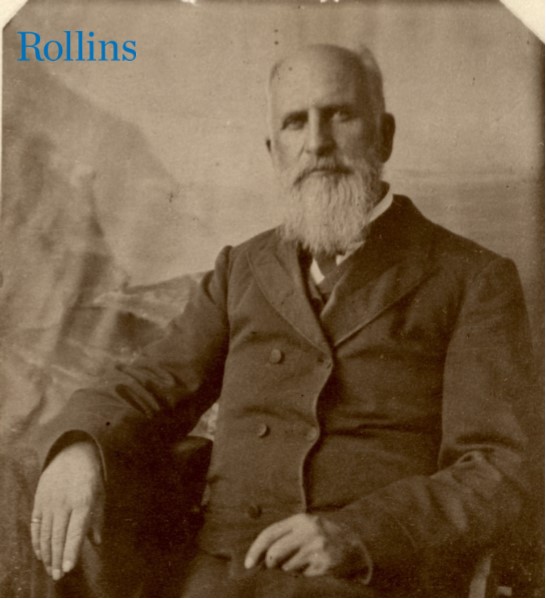
Reverend Edward P. Hooker, the first president of Rollins
This declaration has since been regarded as the first mission statement of the College. Evidently religion had played a dominant role during the early years. According to the original catalogue of Rollins College: “The College is broadly non-sectarian. In the Board of twenty-one Trustees several of the leading denominations are represented, and the only religious qualification for membership in the Board and the Faculty is membership in some Evangelical church. Christ is the corner-stone, and upon this foundation it is hoped to erect a building fitly framed together which shall grow unto a holy temple in the Lord.”[4] When Hooker stepped down and Charles G. Fairchild was named the next president, the College Catalogue noted, “Rollins is a product of the new era in Florida. It was founded by those who felt the need of an institution here maintaining the highest standard of learning, employing modern methods of instruction, and affording careful Christian training.”[5] Although Fairchild’s presidency only last two years (1893-95), the College Charter was revised during his tenure, which reads: “That the object of said college shall be to establish and forever maintain an institution of Christian learning; to promote the general interests of education; to qualify its students to engage in the learned profession or other employments of society, and to discharge honorably and usefully the various duties of life.”[6]
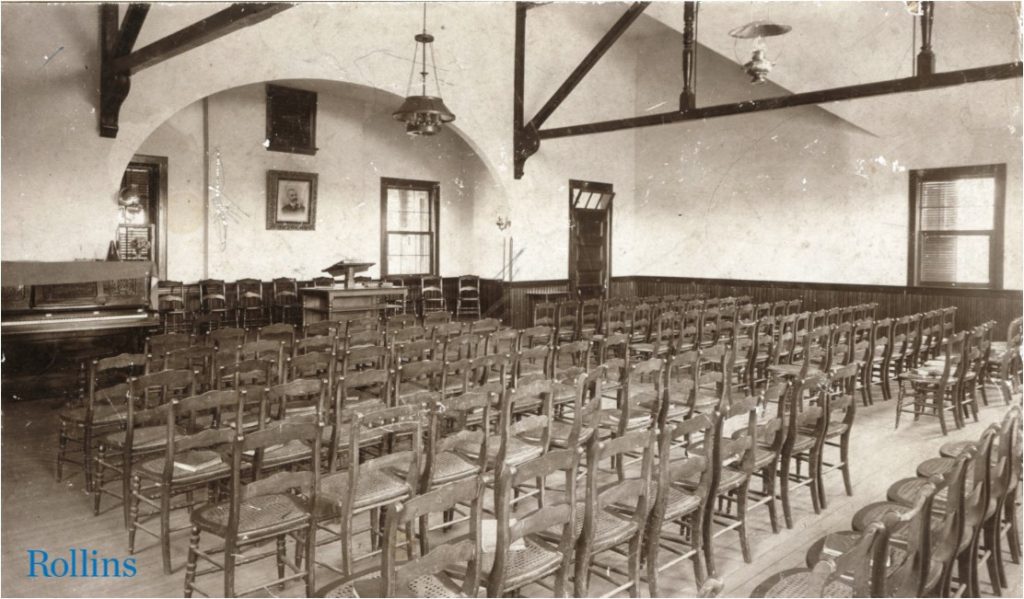
Interior of Knowles Hall, the first building completed by the College. Chapel services were held in this auditorium.
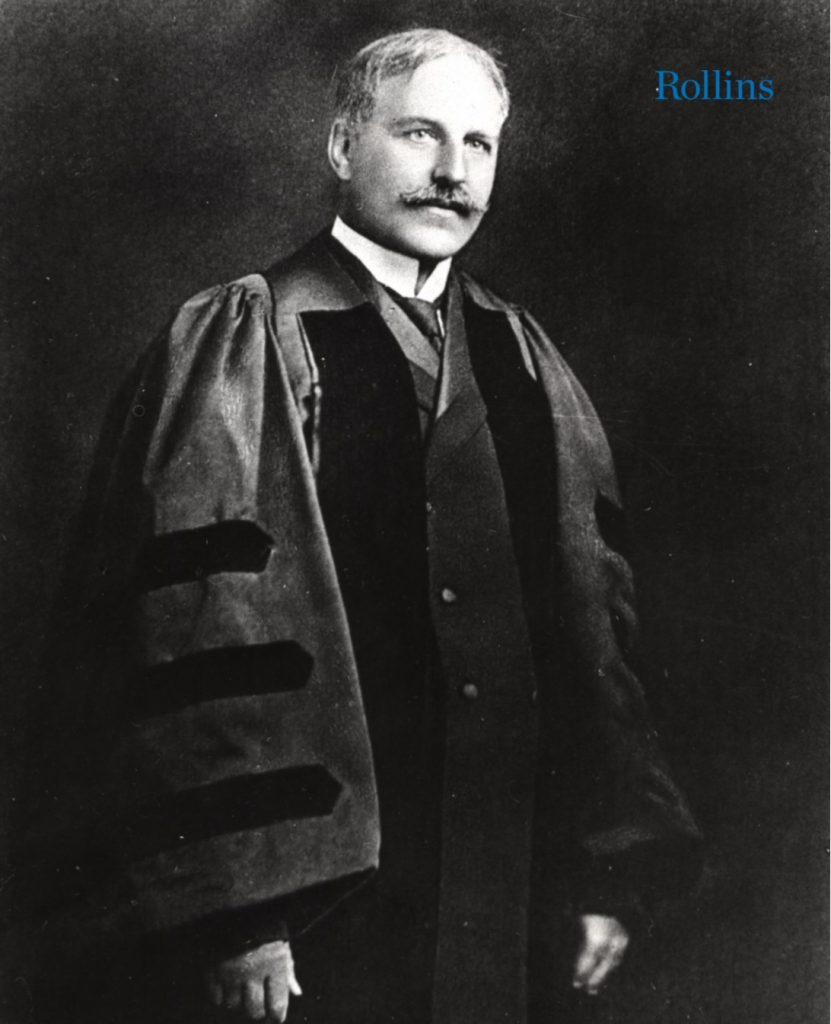
Reverend George Morgan Ward, the third President of Rollins
Rollins’ next president was also a religious leader, Reverend George Morgan Ward (1859-1930), who actually served three different terms (1896-1902, 1916-17, and 1919-21) and provided stable leadership during a turbulent era when Rollins struggled for its survival. As a result, the College retained its Christian character throughout its early existence. In fact, it was during the administration of William Blackman (1902-1915) that Rollins finally severed its tie with the Congregational Church in Florida. To qualify for faculty retirement grants from the Carnegie Foundation, the Board of Trustees voted in 1908 to become an independent institution of liberal arts learning.[7] Consequently, the description of the College was significantly broadened, reflecting the changing curriculum of the time. As noted in the College Catalogue of the early twentieth century: “In the matter of discipline, the object is to aid the student, and the regulations are such as earnest students would impose upon themselves in order to secure the greatest benefit for themselves and for their fellow students; pupils who have not sufficient maturity and self control to study profitably under these conditions are advised to go elsewhere. The aim of the college is not to give undue attention to one side of man’s nature, but rather to secure a symmetrical development to body, mind, and spirit.”[8]
Hamilton Holt and Individualized Education

President Hamilton Holt in 1925-1926 (left) and with students at his home in 1927
In 1925, Hamilton Holt became the eighth president of the College. A journalist by training with little theoretical knowledge of higher education, Holt learned from his student experience at Yale and was determined to make Rollins the best small college of progressive liberal arts in the nation. In one of his writings about the educational mission of Rollins, he noted: “We hold the belief that the individual student’s growth and development are the all-important things, and that to justify itself, every course, by its subject matter and manner of being taught, must deepen and broaden the student’s understanding of life and enable him to adjust himself more quickly and more effectively to the world in which he lives.”[9] A talented individual in media and marketing, Holt diligently promoted Rollins’ new strategic direction with public speeches, essays, and widely distributed pamphlets such as The Rollins College Adventure in Common-Sense Education, Plans for the Development of Rollins College into the Best Small College of Liberal Arts in the United States, and An Experiment That Has Proved Itself. He also recruited famed educational philosopher John Dewey to chair Rollins’ Curriculum Conference for the College of Liberal Arts. Under Holt’s leadership, Rollins began to emerge as a national leader in pragmatic liberal arts education in America.
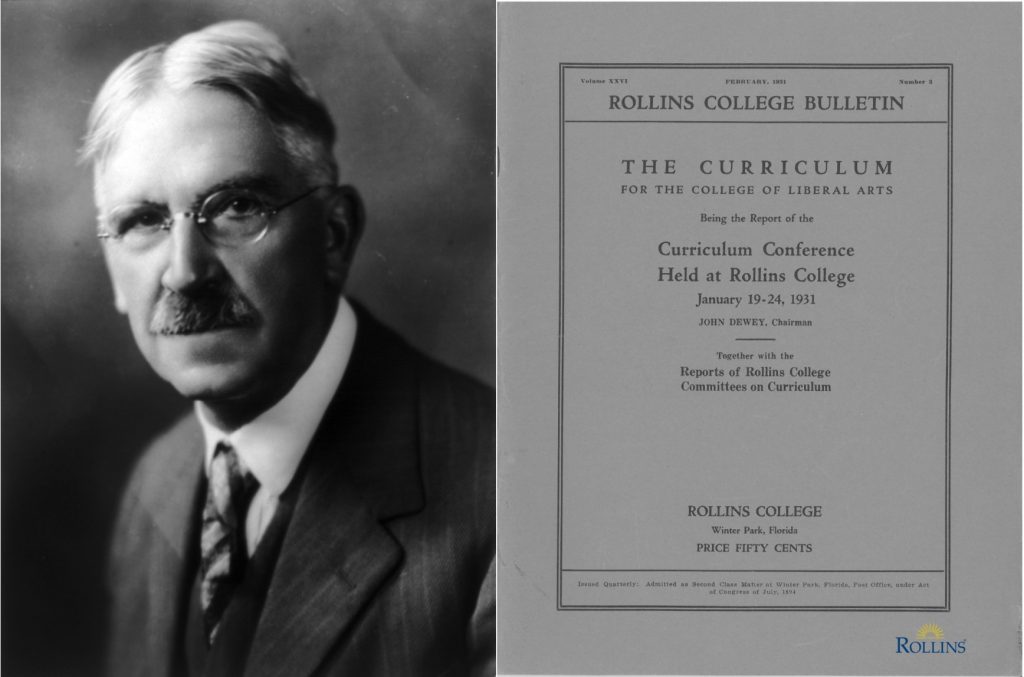
Philosopher John Dewey and the report from the 1931 Curriculum Conference
Throughout the Holt administration, an individualized education had become the central focus of the institution. Accordingly, the Rollins Conference Plan was developed, which emphasized one-on-one interaction between professor and student, so that “both teacher and student would actively participate in the educational process.”[10] College publications contained catchy statements such as “The idea at Rollins is to substitute learning for instruction, to encourage intellectual curiosity and enthusiasm of the students, and to develop the individual in the manner best suited to him.”[11] With a Rollins education, “A well-rounded and complete life is open only to those who, informed by a liberal culture, are freed from the prejudices of a partial knowledge. Students so trained bring to their vocations an intellectual capacity which is of greater value than specific techniques or skills and which enables them to face the problems of modern life honestly and courageously.”[12] Even during the height of World War II, this individualized approach in liberal art education was still accentuated. According to the College Catalogue of 1942-43: “The present world conflict has taught us that democracy can survive only if we utilize to the utmost the talents of each individual. Thus we believe that sound individualization in education is the most effective way to lead our students into paths that will fortify them, as loyal exponents of democratic ideas, to withstand the shocks of these days and prepare them to create a permanent peace resting on the foundation of true democracy.”[13]
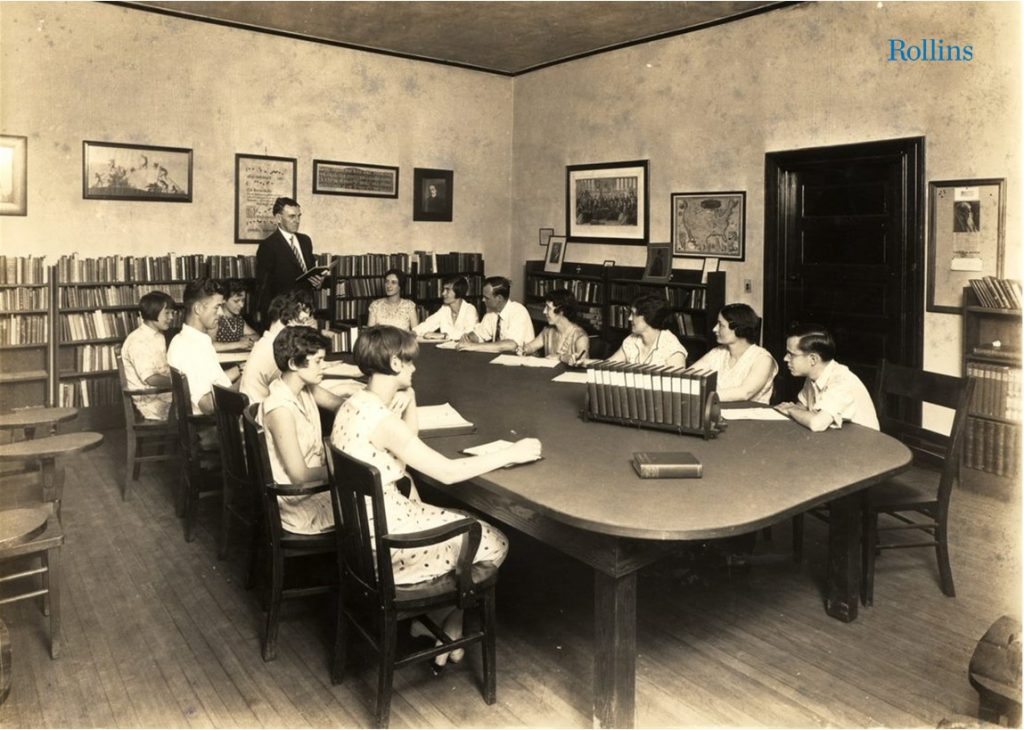
Professor of Books Edwin Grover with students in a classroom designed for the Conference Plan of instruction, 1928-1929
A Distinctively Small and Independent Institution
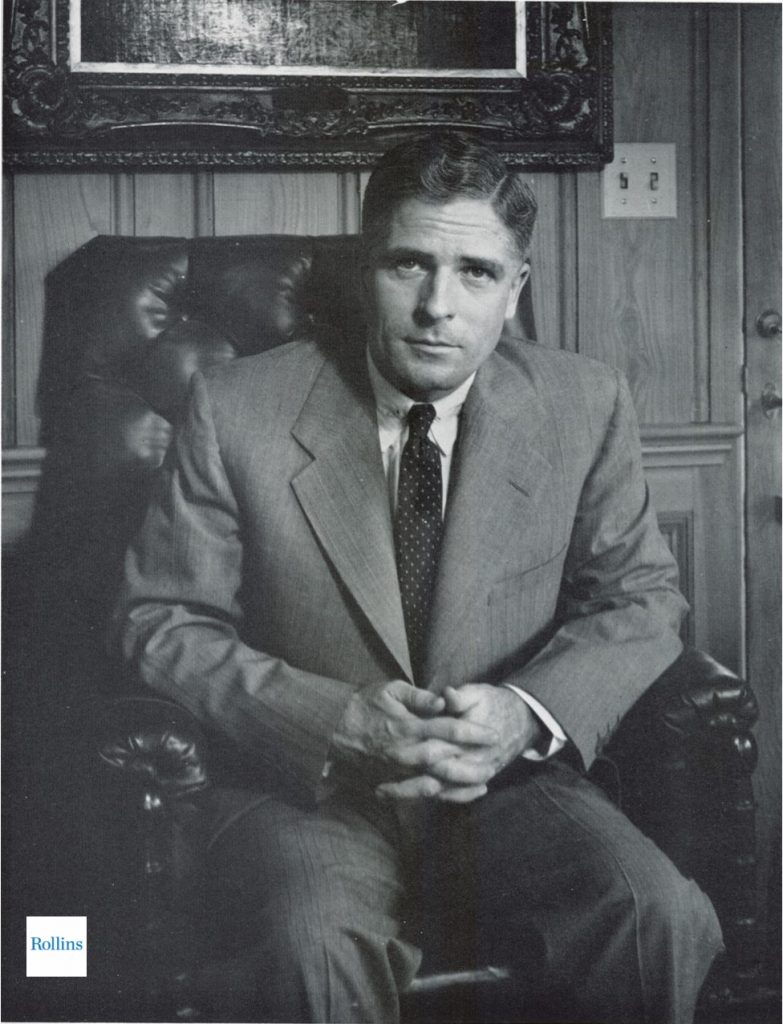
President Hugh McKean, from the 1952 Tomokan yearbook
When Hugh McKean assumed the presidency in 1951, he sought to sustain the liberal arts tradition and Holt’s legacy in individualized education. As described in the 1951-53 College Catalogue: “A pioneer in the Conference Plan, the Individualized Curriculum, and planned smallness as a virtue in education, Rollins is noted chiefly for the individual attention given students through the Conference Plan of Education. It also enjoys a growing reputation for sound training of students who continue their education in outstanding graduate schools in this country and abroad.”[14] Although the 1950s-1960s had been an era of tremendous growth in American higher education, Rollins deliberately chose to remain a distinctively small and independent institution devoted to the highest type of undergraduate liberal education. The College proudly declared that it “should not be size, but quality, highest standards of scholarship, thoroughness of work, fineness of result” which should distinguish Rollins among its contemporaries.[15] “Rollins has long held a place among the liberal arts colleges of the nation as a leader in liberal education. It has resisted the trend toward large size in order to maintain the distinctive qualities of a personalized college.”[16] Given the small and selective nature of the College, by the mid-1960s Rollins was further described as a “liberal arts college devoted to the education of young men and women carefully selected on a basis of character and intellectual capability. Rollins’ enrollment is planned so that each student can be educated as an individual. The college program is aimed at developing the ability to think, write, and speak cogently; and is planned to give the student a broad, integrated knowledge of the basic concepts in methods of physical and behavioral sciences, a lively appreciation of literature and humanities, and a sensitivity to the expressive arts. Concentrated study in a specialized field is a requirement for all students. Every Rollins graduate has received the kind of education leading to sound values and sensible living. Each has had preparation for leadership in his fields of activity.”[17]
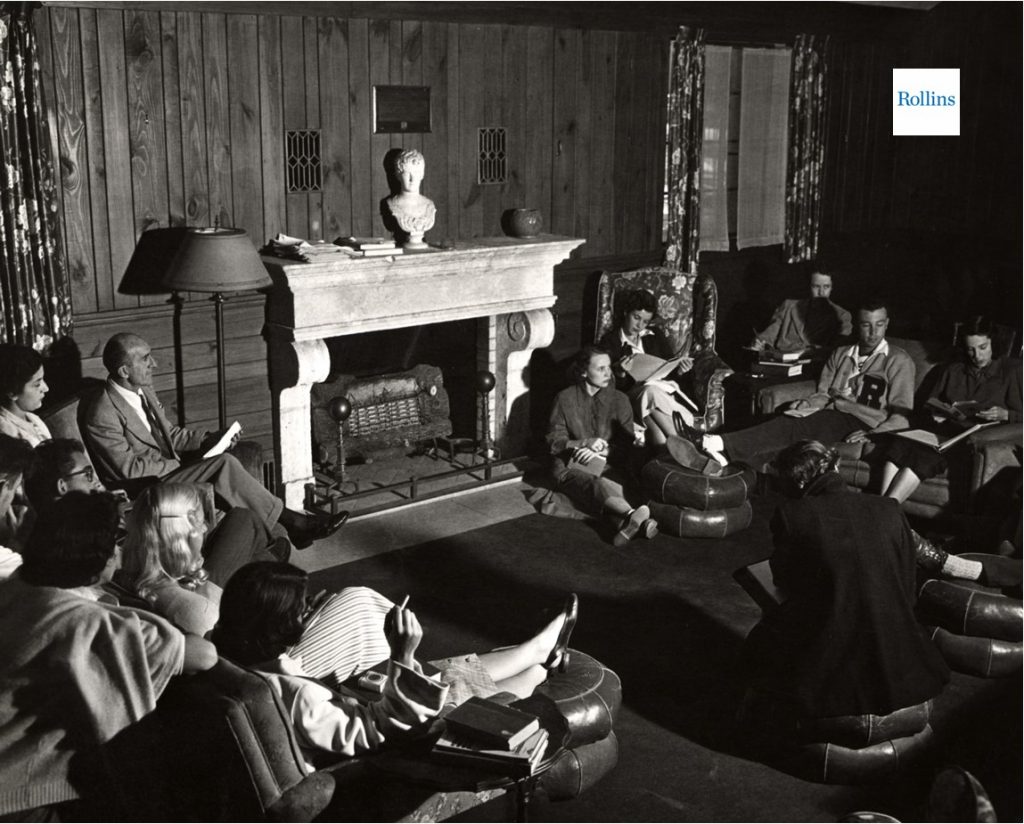
Prof. Edwin Granberry with his English class in Woolson House, circa 1952
In 1969, Jack B. Critchfield became the eleventh president of the College. Under his leadership, the institutional mission was further defined: “Rollins College is dedicated to sound liberal learning for those with the capabilities of leadership. Rollins does not propose an average education for the average student. Its mission is to offer education which emphasizes a maximum effort and commitment to innovative excellence by each student.”[18] A substantial revision took place two years later, as described in the Rollins College Bulletin: “Rollins College stands among the small, coeducational, independent liberal arts institutions which distinctively contribute to the vitality and diversity of American higher education. The purpose of Rollins is to offer a liberal education rather than a wide diversification in specialized training.”[19] Besides the traditional tenets of liberal arts education, the 1972-73 statement also noted the concept of the College as a community of learners. “Realizing that intellectual capacities are best developed through the interaction of people and ideas, Rollins seeks to establish a community of learning in which instructors and students are colleagues in educational endeavor. Within this setting the College hopes to enlarge the individual’s awareness of his capabilities and limitations, stimulate his alertness to contemporary issues and events, deepen sensitivity to beauty, and contribute to his physical well-being. This environment provides opportunity for students, faculty, and administrators to discover and accept responsibilities of membership in a learning community. Rollins fosters the free exploration of the contemplative and creative adventures of the mind, and encourages the individual’s openness to the ideas of others and the development of his confidence in articulating his own views with the integrity that the search for truth demands.”[20] Furthermore, Rollins’ role in continuing education in Central Florida was outlined as well. “The objectives of our College are not directed solely towards today’s young people but to all persons who wish to enrich their lives through higher education. Therefore, Rollins provides continuing education and graduate degree programs which enable the pursuit of either part-time or full-time study in areas related to a variety of expressed needs and interests. Our central goal at Rollins is the development of that intellectual maturity desired by persons not simply seeking for ways to get along, but for ways to realize more of the human potential.”[21]
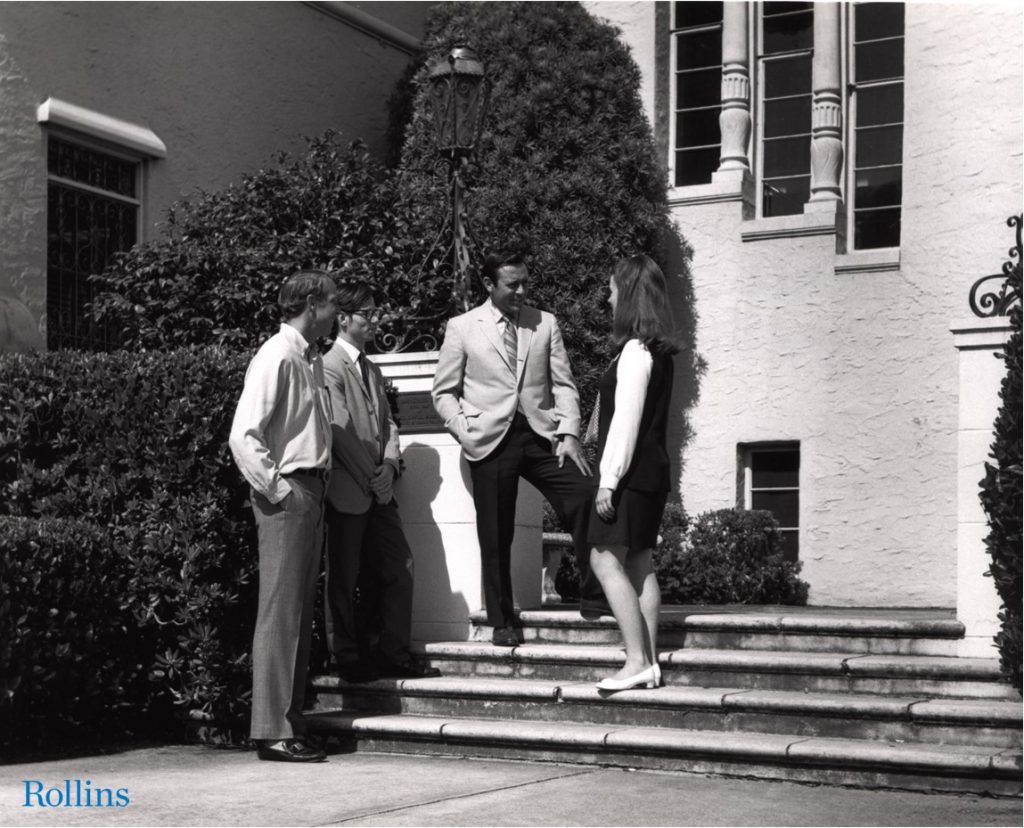
President Jack Critchfield (second from the right) with students in 1970
The Centennial Statement of Educational Objectives
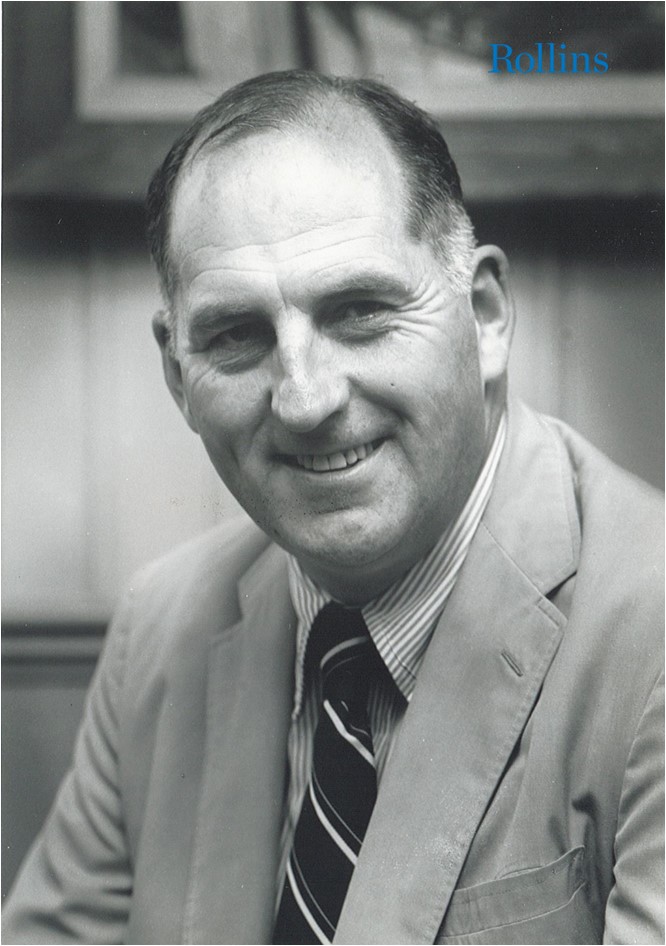
President Thaddeus Seymour, circa 1980
In 1978, Thaddeus Seymour became the twelfth president of the College, and brought a clear vision for Rollins. “Our aim is to know ourselves and to be known by others as the finest small college in the Southeast, standing among the finest small colleges in the country.”[22]
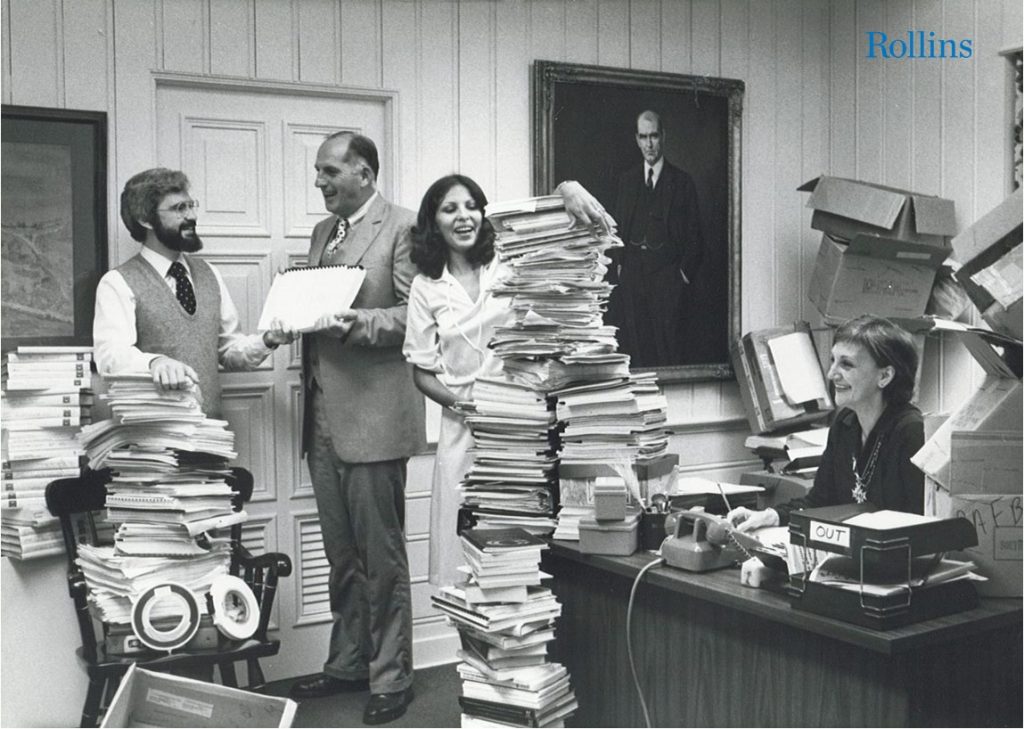
The College Planning Committee was formed in 1979 to “articulate the institutional mission of Rollins College” and develop an institutional agenda for the College’s next five years. Pictured with the committee’s papers are Dean of the Faculty Daniel DeNicola, President Thaddeus Seymour, Secretary Marsha Clore, and Presidential Assistant Connie Riggs.
After an extensive review and study, on February 20, 1981, the Board of Trustees adopted the Centennial Statement of Educational Objectives: “Consistent with the purposes set forth in the 1885 Charter of the College, Rollins will continue to prepare students for ’virtuous and useful lives.’ The future destiny of Rollins College depends on its excellence – the quality of the educational experience, the quality of students and faculty, the quality of individual performance, and the quality of our life and work together.”[23] This statement not only redefines a liberal arts education in modern times, but also addresses key issues such as the diversity of faculty and students, graduate studies, continuing education programs, and community services, while reaffirming Rollins’ commitment as a small, independent institution of higher learning in Florida. It is quoted in its entirety here, given its importance as the most comprehensive mission statement of the time.
For nearly a century, the primary mission of Rollins College has been to provide an excellent liberal arts education for students of ability and promise. It is, and should remain, a small, independent, coeducational institution serving a national constituency. As Rollins looks to its Centennial in 1985, it reaffirms it commitment to excellence.
Rollins seeks to attract and retain a scholarly faculty dedicated to teaching, committed to high standards of performance, and concerned for the welfare of the College and its students. The educational environment is enriched by a diversity of student backgrounds and interests, a climate of academic rigor and intellectual freedom, a beautiful campus with superior facilities, and an atmosphere congenial to the personal and professional development of every member of the community.
The liberal arts evolve. The curriculum at Rollins is faithful to its distinguished ancestry, yet adapted to contemporary society. For Rollins, a liberal arts education includes: a familiarity with the forms of knowledge and modes of experience; the development of communication and research skills; the ability to analyze, synthesize, and evaluate; the development of an informed sense of personal and social values and of self-worth; and a commitment to apply knowledge in the construction of the good. Through education in the liberal arts and sciences, Rollins seeks to foster in its students: self-actualization; a broad cognitive perspective, enabling one to connect, discriminate, and judge wisely; a capacity for self-initiated learning and a commitment to life-long learning; moral and aesthetic sensitivity and a concern for quality in all endeavors; and an appreciation of the diversity, fragility, and dignity of human life.
Rollins affirms as concurrent objectives the provision of quality graduate study in selected professional fields and continuing education programs which are consistent with the liberal arts ideals. Our graduate schools offer to able students a distinctive program of advanced and professional study that reflects the character of the liberal arts. Our programs in continuing education provide important community service. A generous admissions policy is appropriate here when coupled with high academic standards and intellectual vitality.[24]
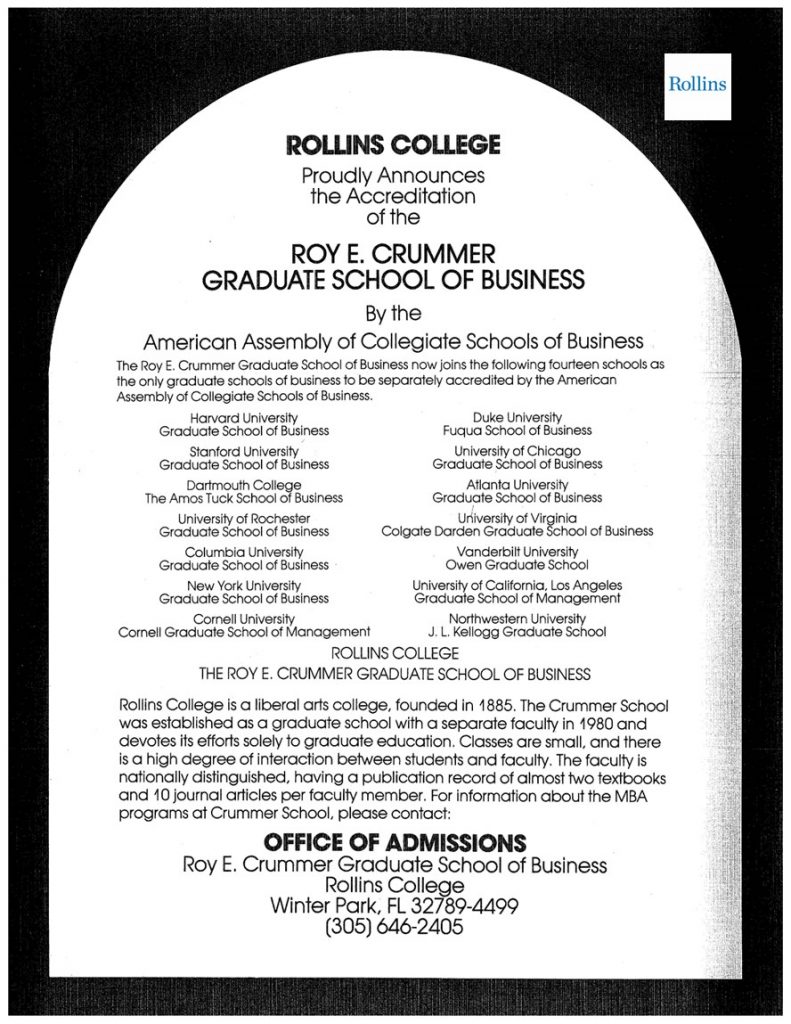
The Crummer Graduate School of Business was first accredited by the American Assembly of Collegiate Schools of Business in April 1985.
A Comprehensive Liberal Arts Institution
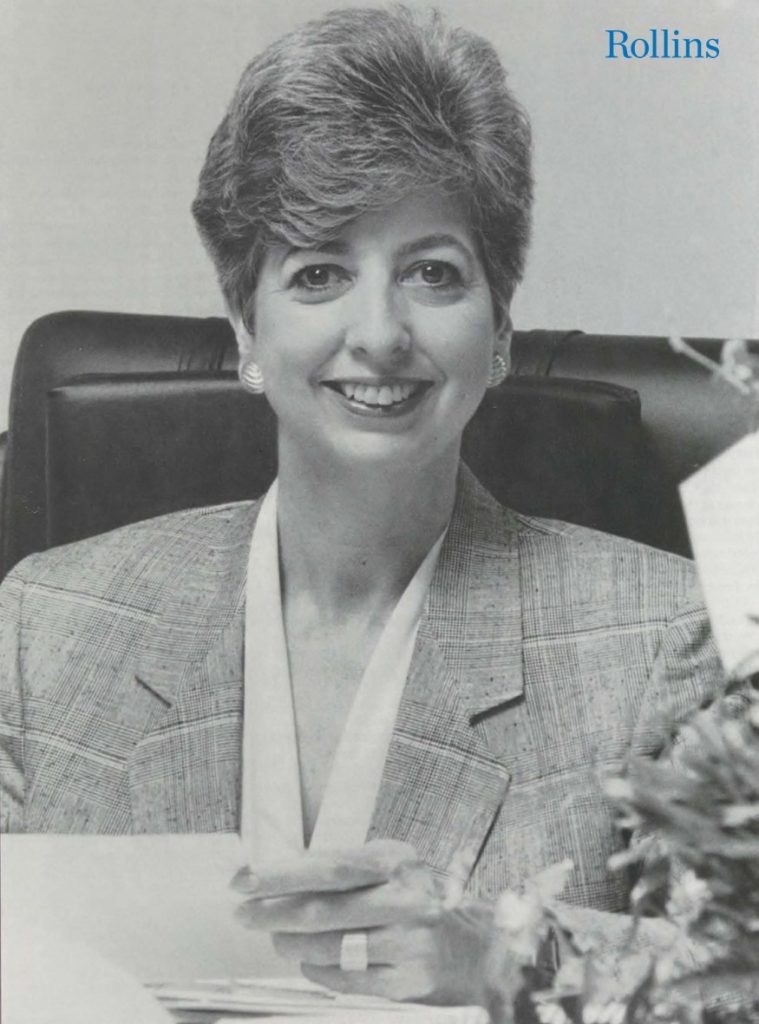
President Rita Bornstein, Fall 1990
When Rita Bornstein was named the thirteenth president of the College in 1990, she swiftly convened a Task Force for the 21st century that consisted of faculty and administrators. After an All-College Summit in the fall of 1991, a new college mission statement was developed with the full support of the academic community. While recognizing the College’s heritage and tradition in educational innovations, this official statement describes Rollins as a comprehensive liberal arts institution, with a central mission of educating students for active citizenship in a global society and disseminating the values of a liberal education in the wider community. After making a renewed commitment to rigorous liberal studies, graduate management and continual education programs in Florida, this substantially revised statement also outlines other priorities for Rollins such as diversity, quality of life, community, and campus architecture. Adopted by the Board of Trustees on February 21, 1992 and cited below, this mission statement served as the guiding document throughout the Bornstein administration.
Rollins College holds a distinctive place in American higher education. From its founding in 1885, the College has emphasized quality liberal education, and, since the 1920s, has developed a tradition of innovation in the liberal arts. Drawing upon this dual heritage, Rollins has also established a nationally recognized graduate management school and continuing education program. United by the values of liberal education and integrated by a single collegiate structure, these diverse programs and student populations distinguish Rollins as a comprehensive liberal arts institution, which educates students for active citizenship in a global society and disseminates the values of a liberal education in the wider community.
The College affirms its commitment to excellence and innovation throughout its programs. Rollins is dedicated to rigorous education in a caring and responsive environment; distinctive programs which are interdisciplinary and collaborative; advancement of the art of teaching; and scholarship and creative endeavor. Continuing priorities are diversity among students, staff, and faculty; the quality of student life; and the integration of a rich array of co-curricular opportunities with the curriculum.
Rollins accepts its historical responsibility to serve the Central Florida community through educational programs and cultural and enrichment activities. Because aesthetic values contribute to a climate in which liberal education flourishes, the College is also committed to preserving the integrity of its architecture and the beauty and environmental health of its lakeside campus.[25]
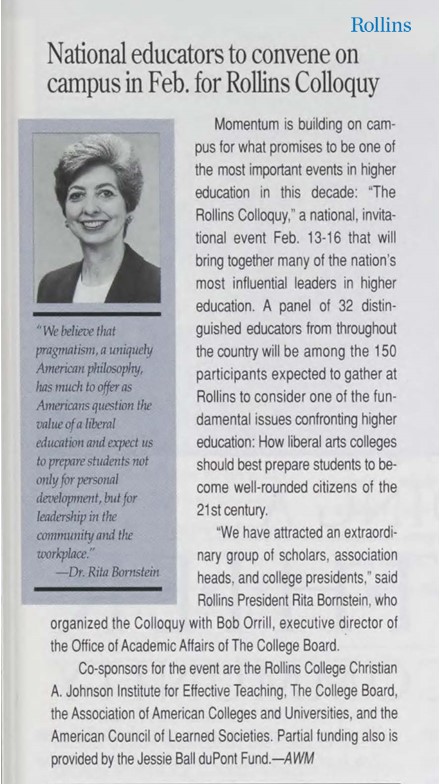
In the spring of 1997, President Bornstein invited higher education leaders from across the country to participate in The Rollins Colloquy, Toward a Pragmatic Liberal Education: The Curriculum of the 21st Century. This event led to the publication of the book Education and Democracy: Re-imagining Liberal Learning in America.
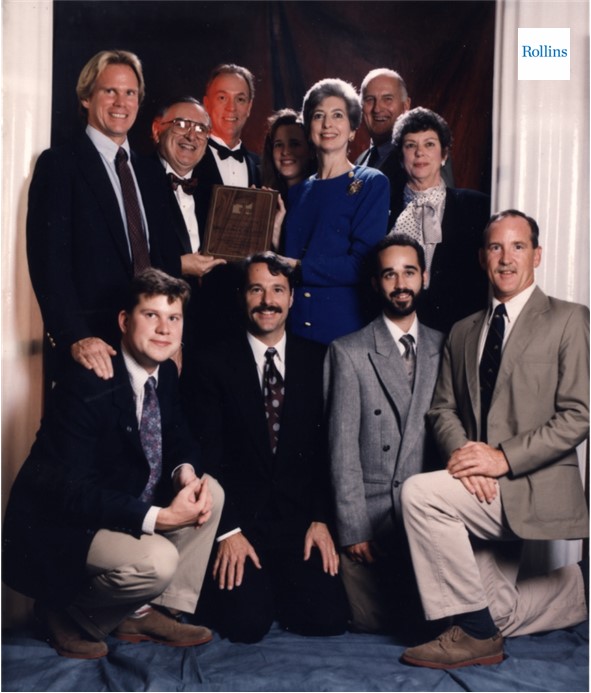
In 1993, the College’s work for Habitat for Humanity was recognized by the Winter Park Chamber of Commerce, who named Rollins “Citizen of the Year.” Among those accepting the award with President Bornstein (center) were President Emeritus Thaddeus Seymour, Polly Seymour, Mark Freeman ’76, Hal George ’76, Angus Guberman ’98, Sharon Beville ’96, Mike Porco ’95, and Rev. John Langfitt ’81.
New Mission for the Twenty-First Century
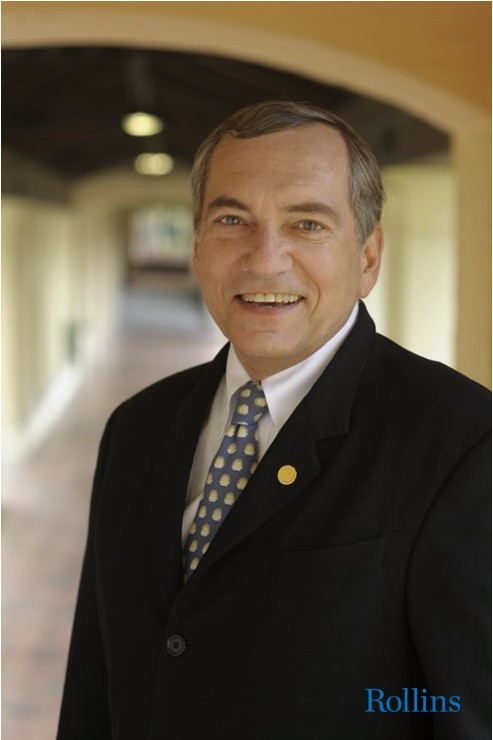
President Lewis Duncan, 2009
After Bornstein’s retirement in 2004, Lewis Duncan was installed as the fourteenth president of the College. He immediately launched a new round of the strategic planning that involved all members of campus community, and on October 21, 2005, the Board of Trustees adopted the following mission statement:
Rollins College educates students for global citizenship and responsible leadership, empowering graduates to pursue meaningful lives and productive careers. We are committed to the liberal arts ethos and guided by its values and ideals. Our guiding principles are excellence, innovation, and community.
Rollins is a comprehensive liberal arts college. Rollins is nationally recognized for its distinctive undergraduate Arts & Sciences program. The Crummer Graduate School of Business offers a nationally ranked MBA program. The Hamilton Holt School serves the community through exceptional undergraduate and graduate evening degree and outreach programs. We provide opportunities to explore diverse intellectual, spiritual, and aesthetic traditions. We are dedicated to scholarship, academic achievement, creative accomplishment, cultural enrichment, social responsibility, and environmental stewardship. We value excellence in teaching and rigorous, transformative education in a healthy, responsive, and inclusive environment.[26]

“As we explore the components of a curriculum that will prepare our students to lead meaningful, responsible, and productive lives in the 21st century, we believe it is critically important to first think about the 21st century, and the fundamental issues, challenges, and promises that our graduates will encounter.” With these words, President Duncan explained the genesis of the 2007 Rollins College Colloquy on Liberal Education and Social Responsibility in a Global Community. Leaders who participated in the colloquy included Francis Fukuyama, Maya Angelou ’85H, and Salman Rushdie.
Notably, the 2005 document clearly identified the four key elements in Rollins’ mission statement: global citizenship, responsible leadership, meaningful lives and productive careers, as well as the three guiding principles of excellence, innovation, and community. This statement was developed in the aftermath of the 9/11 terrorist attacks, in the age of globalization of the twenty-first century; and guided by this document, major college initiatives have been launched in recent years that included the internationalization of the Rollins curriculum and the integration of community engagement across campus. Finally, on May 9, 2014, at the conclusion of the Duncan’s tenure, the Board of Trustees approved the current mission statement:
Rollins College educates students for global citizenship and responsible leadership, empowering graduates to pursue meaningful lives and productive careers. We are committed to the liberal arts ethos and guided by its values and ideals. Our guiding principles are excellence, innovation, and community.
Rollins is a comprehensive liberal arts college. Rollins is nationally recognized for its distinctive undergraduate and selected graduate programs. We provide opportunities to explore diverse intellectual, spiritual, and aesthetic traditions. We are dedicated to scholarship, academic achievement, creative accomplishment, cultural enrichment, social responsibility, and environmental stewardship. We value excellence in teaching and rigorous, transformative education in a healthy, responsive, and inclusive environment.[27]
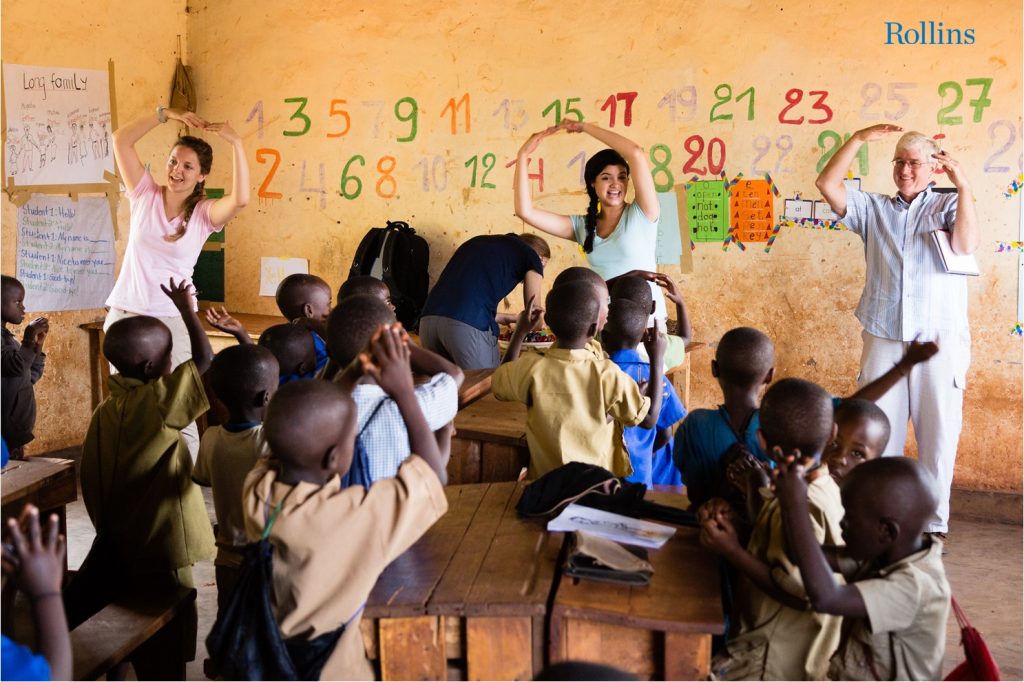
Prof. Scott Hewit (standing on the right) and his students on a field study trip to Rwanda in 2014
A well-crafted mission statement is an important forward-looking document that outlines the future direction of an organization. It not only communicates the institution’s purpose to all key stakeholders and the outside world, but also creates a sense of identity for all employees. Equally important, a clearly defined and shared mission can function as a motivational tool for all members of the community. As the landscape of American higher education has been drastically reshaped over the last century and beyond, the College’s mission has been redefined multiple times to reflect the changing priorities of different eras. What remains constant is Rollins’ unwavering commitment to its historical heritage, innovation and excellence in liberal arts education.
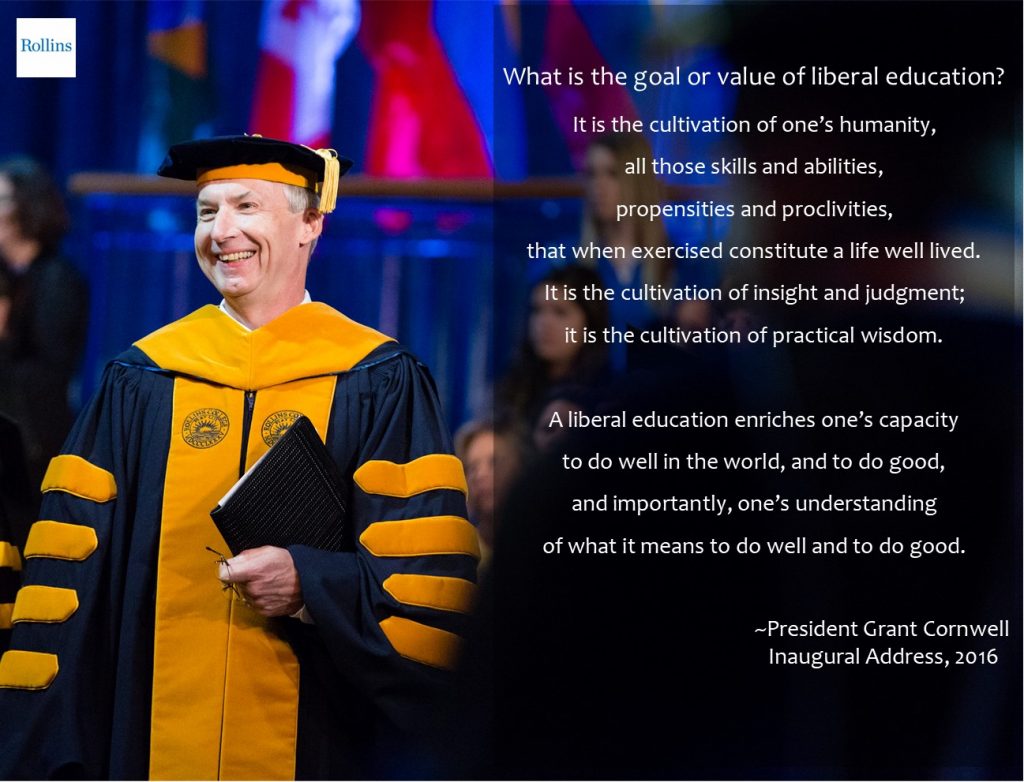
President Grant Cornwell at his Inauguration as the College’s fifteenth president, 2016
[1] Jack Lane, “Founding a Liberal Arts College on the Southern Frontier,” Rollins College: A Pictorial History (Winter Park, FL: Rollins College, 1980), 6.
[2] Jack C. Lane, “Chapter 1: The Founding, 1885” Rollins College: A Centennial History (Winter Park, Florida: Rollins College, 2016), http://scholarship.rollins.edu/mnscpts/11.
[3] “Constitution and Bylaws,” Rollins College General Catalogue (Winter Park, FL: Rollins College, 1885), pp. 13-14.
[4] Ibid, p. 2.
[5] Catalogue of Rollins College (Winter Park, FL: Rollins College, 1892-93), p. 34.
[6] Charter of Rollins College, 05 General Information of the College, Rollins College Archives, Winter Park, Florida.
[7] President William Fremont Blackman and His Administration 1902-1915, Rollins Bulletin, Rollins College Archives, Winter Park, Florida, pp. 24-25.
[8] Catalogue of Rollins College (Winter Park, FL: Rollins College, 1904-05), p. 5.
[9] Hamilton Holt, “On the College Frontier: The Rollins Idea,” The Nation 131:3405 (1930), p. 372.
[10] Jack Lane, “The Evolution of the Rollins Curriculum, 1885-1985” From the Rollins College Archives, December 8, 2018. http://social.rollins.edu/wpsites/libraryarchives/2018/12/06/the-evolution-of-the-rollins-curriculum-1885-1985/.
[11] Catalogue of Rollins College (Winter Park, FL: Rollins College, 1931-32), p. 76.
[12] Rollins College Bulletin Annual Catalogue 1936-1937 (Winter Park, FL: Rollins College, 1936-37), p. 69.
[13] Rollins College Bulletin Annual Catalogue 1942-1943 (Winter Park, FL: Rollins College, 1942), p. 14.
[14] Rollins College Bulletin Catalogue Number 1951-1953 (Winter Park, FL: Rollins College, 1951), p. 2.
[15] Bulletin of Rollins College 1958-1959 (Winter Park, FL: Rollins College, 1958), p. 7.
[16] Ibid, p. 103.
[17] Rollins College Bulletin Catalogue Number 1964-1965 (Winter Park, FL: Rollins College, 1964), p. 14.
[18] Rollins College Bulletin 1970-1971 General Catalog (Winter Park, FL: Rollins College, 1970), p. 6.
[19] Rollins College Bulletin General Catalog 1972-1973 (Winter Park, FL: Rollins College, 1972), p. 11.
[20] Ibid.
[21] Ibid.
[22] Lorrie Kyle, “A Rollins Perspective: Setting the Course,” Rollins Magazine, Fall 2010, https://www.rollins.edu/magazine/archive/fall2010/stories/historical4.html.
[23] Rollins College Catalogue 1981-1982 (Winter Park, FL: Rollins College, 1981), p. V.
[24] Ibid.
[25] Rollins College Catalogue 1992-1993 (Winter Park, FL: Rollins College, 1992), p. 7.
[26] Rollins College Introduction, 2005. https://wayback.archive-it.org/4505/20070702174126/http://rollins.edu/studentrecords/introduction.shtml.
[27] About Rollins: Mission Statement, Rollins College, 2014. https://www.rollins.edu/about-rollins/mission/.
